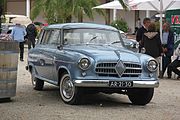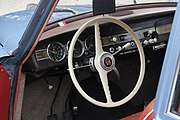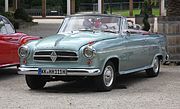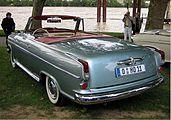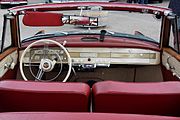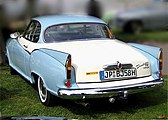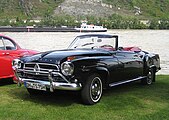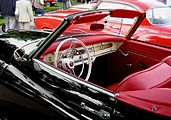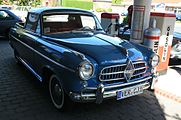Borgward Isabella
| Borgward | |
|---|---|
|
Isabella TS, 1959
|
|
| Isabella | |
| Production period: | 1954-1961 |
| Class : | Middle class |
| Body versions : | Sedan , station wagon , pickup , coupe , convertible |
| Engines: |
Petrol engines : 1.5 liters (44–55 kW) |
| Length: | 4390 mm |
| Width: | 1705 mm |
| Height: | 1480 mm |
| Wheelbase : | 2600 mm |
| Empty weight : | 1040 kg |
| Previous model | Borgward Hansa 1500 |
The Borgward Isabella is a car of the middle class , which the Carl F. W. Borgward GmbH in Bremen Sebaldsbrück built from 1954 to 1961. The vehicle, which was offered exclusively with two doors as standard or as a three-door station wagon, was the most successful model of the Borgward Group. From June 10, 1954, it was initially produced under the name " Hansa 1500".
The later name "Isabella" was not the result of market research, but a spontaneous inspiration from Carl F. W. Borgward himself. When asked what to write on the still top secret pre-production models when they take test drives in public transport, Borgward is said to have answered: " I don't care; writes Isabella on it for me. ”From 1957 the original cover name was to be read in the Borgward rhombus of the radiator grille. The US company BorgWarner complained in early 1958 that the tip of the rhombus - Borgward's trademark - separated the company name on the bonnet in Borg and was and could cause confusion with his name. A lawsuit was threatened, whereupon the rhombus on the Isabella models was reduced in size from mid-1958, thus avoiding the visual separation of the company name.
The modern design and the pleasing appearance of the Hansa 1500 (Isabella) were enthusiastically welcomed when it was launched in 1954. The car met the public's taste and was a sales success from day one. After a development time of only ten months, the model initially suffered from numerous small defects, which were gradually eliminated.
Conception of Isabella
The Isabella was a new design that had little in common technically and externally with the previous model Hansa 1500/1800. Carl FW Borgward himself designed the body and made plasticine models on a 1: 5 scale. Walter Dziggel, Hermann Lünsmann and Hermann Böse were responsible for further development. The new self-supporting body with bulges on the wheel arches, accentuated door sills and a chrome trim strip on the side was no longer as severe as the smooth pontoon body of the previously built Borgward Hansa 1500 , which was introduced in 1949 as the first German car to be redesigned after the war, and it was slightly lighter. The Isabella also differed from its predecessor in other ways. The chassis no longer had leaf springs and the engine had a smaller stroke ratio (1.13 instead of 1.28) and higher compression (7 instead of 6.3).
The Isabella's front wheels are suspended from double wishbones with coil springs and an anti-roll bar (as in the Borgward RS racing car ). The engine and front axle sit on a subframe. At the rear it has a pendulum axle with push rods and coil springs.
The four-cylinder in- line engine with a triple-bearing crankshaft and parallel hanging valves has a side camshaft that is driven by a spur gear with a gear made of fabric-reinforced phenolic resin ( Novotex ). The intake pipe is part of the cylinder head; the carburetor is flanged onto the valve cover. The hydraulically operated clutch was new at the time . The four-speed gearbox with steering wheel shift is fully synchronized .
At 7,265.00 DM, the Isabella was more expensive than the Opel Rekord or the Ford 12 M , but cheaper than a Mercedes 180 . In the first year of production, Borgward made 11,150 Isabellas.
Further development and variants of the Isabella
Station wagon and convertible
In the autumn of 1955, the two-door sedan was accompanied by a three-door station wagon and a convertible . In addition, the Isabella TS was brought onto the market with more engine power (55 kW = 75 PS instead of 44 kW = 60 PS). The TS model was externally recognizable by the corresponding lettering on the rear and by parking lights on the front fenders. The rear door of the station wagon ("combi") was hinged on the left in the first version. However, it turned out to be impractical and was changed to an overhead tailgate during the construction period.
For model year 1957, in December 1956, the cooling slots under the radiator grille were omitted and the “Hansa 1500” logo in the rhombus was replaced by “Isabella”. For the 1958 model year, the car was given a dashboard with a fashionable ribbon tachometer, which replaced the small round instruments of the first generation. For the 1959 model year, the rhombus was reduced in size in August 1958 and the narrower rear lights of the Hansa 2400 were adopted for the Isabella. The last changes before the end of production were in January 1961 a new dashboard - again with round instruments - and a grille behind the radiator opening.
The cabriolet was designed by Johannes Beeskow , who had already designed a coupé based on the Borgward Hansa 1500. It was built by Karl Deutsch GmbH in Cologne. Difficulties were caused by the low rigidity of the self-supporting body without a roof. The interventions in the original construction were correspondingly extensive and expensive. The convertible cost 9,950.00 DM.
The station wagon cost 7,565.00 DM.
- Isabella “combi” and convertible
Borgward Isabella Coupe
When sales of the Isabella had fallen by almost a third compared to 1955 in 1956, Carl Borgward decided to build a “beautiful car” with a shortened roof. This led to the creation of the Borgward Isabella Coupé, of which four prototypes initially made it public and aroused the interest of the press. Borgward gave one of these handcrafted prototypes to his wife Elisabeth at Christmas 1956, who drove it until the 1980s. Series production of the coupé (with the TS engine), of which around 9,500 to a maximum of 10,000 units were built, began in January 1957. Due to the short roof structure and the 12 centimeters lower height, the car looked long and elegant, although it was 4, 40 m no longer than the limousine was. The engine, which accelerated the Coupé from 25 km / h in fourth gear to a top speed of 150 km / h, was shown to be elastic and smooth-running in car tests.
Karl Deutsch in Cologne also converted this model into a convertible, which, however, kept the “Coupé” logo on the rear. The Coupé-Cabriolets cost between 15,600 and 17,000 DM.
Upon request, the coupé was available with the tail fins , which were popular at the time, and included indicators that were larger than the standard version.
- Isabella Coupé and "Coupé-Cabriolet"
Borgward Isabella pickup
A pickup was produced exclusively for export, especially to the USA .
Police vehicle and taxi
The Bremen police used the Isabella as a patrol car , the Hessian police, among other things, in Frankfurt am Main as a speed measuring vehicle.
The Isabella, which was only available with two doors, was hardly suitable as a taxi . However, two four-door conversions are known, one of which was seen at the Borgward meeting in Bad Neuenahr in 2014 .
Technical specifications
| Vehicle type: | Borgward Isabella | Borgward Isabella TS |
|---|---|---|
| construction time | 06/1954 to 09/1961 | 09/1955 to 09/1961 |
| Engine: | Four-cylinder four-stroke in-line engine; water-cooled, overhead valves operated via bumpers and rocker arms, side camshaft, triple bearing crankshaft, a downdraft carburetor type Solex 32 PJCB (TS: 32 PAITA) |
|
| Displacement : | 1493 cc | |
| Bore × stroke: | 75 × 84.5 mm | |
| Compression: | 7: 1 | 8.2: 1 |
| Performance at 1 / min: | 44 kW (60 hp) at 4700 | 55 kW (75 PS) at 5200 |
| Max. Torque at 1 / min: | 108 Nm at 2400 | 114 Nm at 3000 |
| Transmission: | 4-speed gearbox with steering wheel gearshift (rear wheel drive) | |
| Front suspension: | 2 triangular wishbones of unequal length, coil springs, telescopic shock absorbers, stabilizer | |
| Rear suspension: | Pendulum axle with thrust struts, coil springs, telescopic shock absorbers | |
| Steering: | ZF - roller steering | |
| Brakes: | Drums (front duplex) | |
| Body: | self-supporting all-steel body | |
| Wheelbase : | 2600 mm | |
| Dimensions L × W × H: | 4390 × 1705 × 1480 mm (from August 1958: 4400 × 1760 × 1500 mm) | |
| Empty weight (without driver): | 1040 kg (TS: 1060 kg) | |
| Top speed: | 135 km / h | 150 km / h |
| Acceleration 0 - 100 km / h: | 25 s | 19 s |
| Consumption per 100 km: | 8 to 10 liters of regular gasoline | 8 to 10 liters of premium gasoline |
Isabella in motorsport
Borgward used the Isabella in motorsport right from the start. At the Carrera Panamericana in October 1954 , Adolf Brudes started with the standard 60 hp engine in the “European touring car up to 2 liter displacement” class, in which the Alfa Romeo works team competed with several 110 hp “1900 TI” cars. There were also seven VW Beetles with 30 hp engines. In keeping with the balance of power, Brudes took sixth place behind five Alfa Romeos and ahead of the VW Beetles, all of which made the 3,070 km route. Brudes drove the race at an average of 113 km / h. In the following years, the Isabella could also be seen with more powerful engines in touring car races , including as part of the supporting program for the European Grand Prix on August 6, 1961 at the Nürburgring with Jochen Neerpasch and Robert Franz (pseudonym) at the steering wheel.
End of production
In 1961 the Borgward Group became insolvent. Many vehicles were on the dump; nevertheless, the Isabella remained in production until 1962. A total of 202,862 units had been built by the end of production. The production facilities were sold to Mexico, where some of these vehicles were still being manufactured during the 1960s. From 1961 , BMW filled the Isabella's position in the market with the BMW E115 (BMW 1500).
Web links
Individual evidence
- ^ Market for classic automobiles and motorcycles , issue 7 / July 1987, page 142
- ↑ a b c d Peter short: Borgward typology . Delius Klasing Verlag, Bielefeld 2009, ISBN 978-3-7688-2599-3 .
- ↑ storm.oldcarmanualproject.com/borgwardisabella.htm
- ^ Achim Schmidt, Kai Schwarz: Police vehicles, pages 66–73, Sammüller Kreativ GmbH, 2006 ISBN 978-3-89736-328-1
- ↑ stevemckelvie.wordpress.com/2011/04/25/borgward-isabella-coupe/
- ↑ tocmp.org/borgward/3508.jpg Table of technical data
Literature and Sources
- Peter Kurz: Cars from Bremen. Volume 3, Verlag Peter kurz , Bremen 2001, ISBN 3-9806977-3-8
- Peter Kurz: Borgward Isabella - From the drawing board to the roll-out . Verlag Peter Kurz, Bremen 2020, ISBN 978-3-927485-08-2
- Heinrich Völker: The way to Borgward Isabella - unknown from the test department. Verlag Peter Kurz, Bremen 2003, ISBN 978-3-927485-27-3
- Georg Schmidt: Borgward. Motorbuch Verlag, Stuttgart 1986, ISBN 3-87943-679-7
- Motor classic. Issue 1/2004, Vereinigte Motor-Verlage, Stuttgart
- Arthur Westrup (ed.); Klaus Hansen (Ps. For Karl-Heinz Wassmann) (Red.): My experiences with the Borgward Isabella (= my experiences with the… , Volume 4). Bielefeld, Delius, Klasing & Co .: 1957, 40 pages.
- Peter Michels: The Borgward Isabella Book. (A book of the "type series".) Brilon: Podszun-Motorbücher, 1987, 96 pages. ISBN 3-923448-40-6
- Christian Steiger (Ed.): Borgward Isabella: Fräulein-Wunder. Stuttgart: Schrader, 1997, 128 pages. ISBN 3-613-87165-3
- Peter Short; Harm Coordes: Borgward Isabella. A masterpiece point by point. Bielefeld: Delius Klasing 2004, 110 pages. ISBN 3-7688-1551-X
- Heinz Flieger: The way to Isabella. A history of the Borgward group (German economic biographies, volume 1) Düsseldorf: Verlag für Deutsche Wirtschaftsbiographien, 1959, 191 pages






